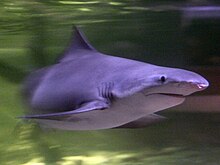River shark
| River shark Temporal range:
| |
|---|---|

| |
| Speartooth shark (Glyphis glyphis) at the Melbourne Aquarium | |
| Scientific classification | |
| Domain: | Eukaryota |
| Kingdom: | Animalia |
| Phylum: | Chordata |
| Class: | Chondrichthyes |
| Subclass: | Elasmobranchii |
| Order: | Carcharhiniformes |
| Family: | Carcharhinidae |
| Genus: | Glyphis Agassiz, 1843 |
| Type species | |
| Carcharias (Prionodon) glyphis Müller & Henle, 1839
| |
Glyphis is a genus in the family Carcharhinidae, commonly known as the river sharks. They live in rivers or coastal regions in and around south-east Asia and parts of Australia.
Taxonomy
This genus contains only three extant species. Further species could easily remain undiscovered, due to their secretive habits.[2] This genus was thought to contain five different species, but recent studies on molecular data revealed that the species Glyphis gangeticus has an irregular distribution in the Indo-West Pacific region.[3]
Species
The recognized species in this genus are:[4]
- Glyphis fowlerae Compagno, White & Cavanagh, 2010 (Borneo river shark) synonym of G. gangeticus[2]
- Glyphis gangeticus (J. P. Müller & Henle, 1839) (Ganges shark)
- Glyphis garricki L. J. V. Compagno, W. T. White & Last, 2008 (northern river shark)
- Glyphis glyphis (J. P. Müller & Henle, 1839) (speartooth shark)
- †Glyphis hastalis Agassiz, 1843[1]
- †Glyphis pagoda (Noetling, 1901)
- Glyphis siamensis (Steindachner, 1896) (Irrawaddy river shark) synonym of G. gangeticus[2]
Distribution and habitat
Their precise geographic range is uncertain, but the known species are documented in parts of South Asia, Southeast Asia, New Guinea[5] and Australia. Of the three currently described species, the Ganges shark is restricted to freshwater, while the northern river shark and the speartooth shark are found in coastal marine waters, as well. While the bull shark (Carcharhinus leucas) is sometimes called both the river shark and the Ganges shark, it should not be confused with the river sharks of the genus Glyphis. River sharks evolved to have their offspring in freshwater, therefore, making them safe to roam in the water while other sharks are able to survive in saltwater.
Conservation
River sharks remain very poorly known to researchers. They are facing a critically endangered status since they are so poorly studied, and people know very little about their population and life history. Glyphis gangeticus uses the Ganges River as nursery grounds and the birthplace of many Ganges shark offspring, however the population has been severely diminished owing to a long history of fishing and other pollution related issues in the Northern Arabian Sea. Additionally, India, where the Ganges river flows, is reported to be one of the top three greatest shark and ray capturers in the world, accounting for up to 9 percent of reported global landings (Jabado et al., 2018). They have been found in nine different tidal areas, which consist of muddy waters with a low salinity. Their placement in connection to coastal marine waters indicates that they are usually born around October.[5]
Images
-
Ganges shark (G. gangeticus)
-
Northern river shark (G. garricki)
-
Speartooth shark (G. glyphis)
![]() Media related to Glyphis at Wikimedia Commons
Media related to Glyphis at Wikimedia Commons
References
- ^ a b "Glyphis Agassiz 1843 (river shark)". Fossilworks.
- ^ a b c Li, Chenhong; Corrigan, Shannon; Yang, Lei; Straube, Nicolas; Harris, Mark; Hofreiter, Michael; White, William T; Naylor, Gavin J. P (2015). "DNA capture reveals transoceanic gene flow in endangered river sharks". Proceedings of the National Academy of Sciences. 112 (43): 13302–7. Bibcode:2015PNAS..11213302L. doi:10.1073/pnas.1508735112. PMC 4629339. PMID 26460025.
- ^ Jabado, R. W.; Kyne, P. M.; Nazareth, E.; Sutaria, D. N. (2018). "A rare contemporary record of the Critically Endangered Ganges shark Glyphis gangeticus". Journal of Fish Biology. 92 (5): 1663–1669. doi:10.1111/jfb.13619. ISSN 1095-8649. PMID 29611178.
- ^ Bailly, Nicolas (2014). "Glyphis Agassiz, 1843". WoRMS. World Register of Marine Species. Retrieved 6 July 2023.
- ^ a b White WT; Appleyard SA; Sabub B; Kyne PM; Harris M; Lis R; et al. (October 7, 2015). "Rediscovery of the Threatened River Sharks, Glyphis garricki and G. glyphis, in Papua New Guinea". PLoS ONE. 10 (10): e0140075. Bibcode:2015PLoSO..1040075W. doi:10.1371/journal.pone.0140075. PMC 4596488. PMID 26445387.



